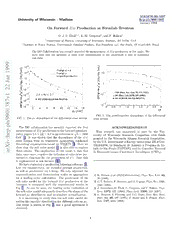
On Forward J/ψProduction at Fermilab Tevatron PDF
Preview On Forward J/ψProduction at Fermilab Tevatron
MADPH-99-1097 University of Wisconsin - Madison hep-ph/9901387 January 1999 On Forward J/ψ Production at Fermilab Tevatron O. J. P. E´boli1,2, E. M. Gregores1, and F. Halzen1 1Department of Physics, University of Wisconsin, Madison, WI 53706, USA 2Instituto de F´ısica Te´orica, Universidade Estadual Paulista, Rua Pamplona 145, S˜ao Paulo, SP 01405-900, Brazil TheDØ Collaboration has recentlyreported themeasurement of J/ψ production at low angle. We show here that the inclusion of color octet contributions in any framework is able to reproduce this data. 9 9 9 1 n a J 2 2 CDF (Phys. Rev. Lett. 79, 572 (1997)) 1 DØ (Phys. Lett. B370, 239 (1996)) v DØ (FERMILAB-Pub-98/237-E) 7 DØ (FERMILAB-Pub-98/237-E) 8 3 1 0 9 FIG.2. The pseudorapidity dependence of the differential 9 FIG.1. The pT dependenceof the differential cross section cross section / h p - The DØ collaboration has recently reported the first ACKNOWLEDGMENTS p measurementofJ/ψproductionintheforwardpseudora- This research was supported in part by the Uni- e pidityregion2.5 η 3.7inpp¯collisionsat√s=1800 h ≤| |≤ versity of Wisconsin Research Committee with funds GeV [1]. It was shown that the dependence of the J/ψ : granted by the Wisconsin Alumni Research Foundation, v cross section with its transverse momentum confirmed bytheU.S.DepartmentofEnergyundergrantDE-FG02- i X theoretical expectations based on NRQCD [2]. Here we 95ER40896, by Fundac¸a˜o de Amparo `a Pesquisa do Es- show that the soft color model [3] is also able to explain r tadodeSa˜oPaulo(FAPESP),andbyConselhoNacional a these results. The implication of this result is that this de Desenvolvimento Cient´ıfico e Tecnol´ogico (CNPq). data,oncemore,requirestheinclusionofcoloroctetper- turbative diagrams for the production of ψ’s. How this is implemented is not decisive [3,4]. Wehaveevaluatedψproductionfollowingreference[3]. Like the measurement, we included prompt production, as well as production via b-decay. We only adjusted the renormalization and factorization scales as appropriate [1] B.Abbottetal.(DØCollaboration), Phys.Rev.Lett.82, for a leading order calculation. The predictions of the 35 (1999). soft color model for the forward J/ψ production at the [2] G.T.Bodwin,E.Braaten,andG.Lepage,Phys.Rev.D51, Tevatron is compared with the experimental results in 1125 (1995). Fig. 1. As can be seen, the leading order evaluation of [3] J.Amundson,O.E´boli,E.Gregores,andF.Halzen,Phys. thesoftcolormodeladequatelydescribestheshapeofthe Lett. B372, 127 (1996); Phys.Lett. B390, 323 (1997). forward p distribution and its absolute normalization. [4] E. Braaten, S. Fleming, and T.C. Yuan, Ann. Rev. Nucl. T It is interesting to verify that the soft color model de- Part. Sci. 46, 197 (1996); P. Hoyer and S. Peigne, Phys. scribes the rapidity distribution for different cuts on p . Rev.D57, 1864 (1998). T The result is shown in Fig. 2, and a good agreement is obtained. 1
